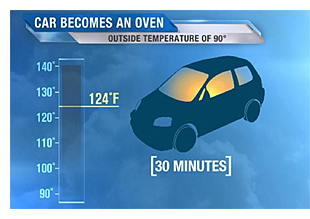
Summer heat brings health cautions
(NOTE: High temperatures in the Boise area have ranged between 90 and 108 since July 3. An extended forecast through July 31 suggests every day will be at least 90 degrees and most daytime maximums will be in the mid- to upper 90s.)
Children and pets left unattended in vehicles as outside temperatures rise aren’t the only potential victims of heat-related death – so are the elderly, those with extenuating health conditions and people who work or recreate outside for long periods of time.
The National Weather Service reports that heat is the number one weather-related killer in the U.S. On average, excessive heat claims more lives each year than floods, lightning strikes, tornadoes and hurricanes combined.
More than 1,250 people died during the tragic heat wave of 1980. In 1995, more than 700 deaths in the Chicago area were attributed to heat, and in August 2003, a record heat wave in Europe claimed an estimated 50,000 lives.
“North American summers are hot; most summers see heat waves in one or more parts of the United States. East of the Rockies, they tend to combine both high temperature and high humidity; although some of the worst heat waves have been catastrophically dry,” the weather service reports.
More information from the National Weather Service:
The hazards of excessive heat
When the body heats too quickly to cool itself safely, or when you lose too much fluid or salt through dehydration or sweating, your body temperature rises and heat-related illness may develop. Heat disorders share one common feature: the individual has been in the heat too long or exercised too much for his or her age and physical condition.
Studies indicate that, other things being equal, the severity of heat disorders tends to increase with age. Conditions that cause heat cramps in a 17-year-old may result in heat exhaustion in someone 40 years old, and in heat stroke in a person over 60.
Sunburn, with its ultraviolet radiation burns, can significantly retard the skin's ability to shed excess heat. Acclimatization has to do with adjusting sweat-salt concentrations, among other things. The idea is to lose enough water to regulate body temperature, with the least possible chemical disturbance – salt depletion.
 Children, adults and pets enclosed in parked vehicles are at great risk
Children, adults and pets enclosed in parked vehicles are at great risk
(see related story)
Each year, dozens of children left in parked vehicles die from hyperthermia.
Hyperthermia is an acute condition that occurs when the body absorbs more heat than it can handle. Hyperthermia can occur even on a mild day. Studies have shown that the temperature inside a parked vehicle can rapidly rise to a dangerous level for children, pets and even adults. Leaving the windows slightly open does not significantly decrease the heating rate. The effects can be more severe on children because their bodies warm at a faster rate than adults.
"But it's a dry heat..."
Many residents and visitors to the desert Southwest think that relative humidities are low, and that they do not need to worry about heat stress. While high relative humidities can increase the adverse effects of heat on the human body, the hottest of days in New Mexico can result in numerous health issues.
Sun burn: Redness and pain. In severe cases swelling of skin, blisters, fever, headaches.
First aid: Ointments for mild cases if blisters appear and do not break. If breaking occurs, apply dry sterile dressing. Serious, extensive cases should be seen by physician.
Heat cramps: Painful spasms usually in muscles of legs and abdomen possible. Heavy sweating.
First Aid: Firm pressure on cramping muscles, or gentle massage to relieve spasm. Give sips of water. If nausea occurs, discontinue use.
Heat exhaustion: Heavy sweating, weakness, skin cold, pale and clammy. Pulse thready (scarcely perceptible). Normal temperature possible. Fainting and vomiting.
First aid: Get victim out of sun. Lay down and loosen clothing. Apply cool, wet cloths. Fan or move victim to air conditioned room. Sips of water. If nausea occurs, discontinue use. If vomiting continues, seek immediate medical attention.
Heat stroke (or sunstroke): High body temperature (106° F. or higher). Hot dry skin. Rapid and strong pulse. Possible unconsciousness.
First aid: Heat stroke is a severe medical emergency. Summon emergency medical assistance or get the victim to a hospital immediately. Delay can be fatal.
Move the victim to a cooler environment Reduce body temperature with cold bath or sponging. Use extreme caution. Remove clothing, use fans and air conditioners. If temperature rises again, repeat process. Do not give fluids. Persons on salt restrictive diets should consult a physician before increasing their salt intake.
Heat stress safety:
-
Drink plenty of water. It is very easy to become dehydrated without realizing it.
-
Avoid alcoholic or caffeinated beverages. Both increase stress on the body and actually accelerate dehydration.
-
Wear light, loose-fitting clothing.
-
Stay out of the sun.
-
Shift strenuous outdoor activities too cooler parts of the day, especially during the early morning.
-
Check on elderly friends, neighbors and family often. Elders are generally more susceptible to heat-related illness.
Take advantage of air conditioning when possible. Many homes in New Mexico still use evaporative cooling (swamp coolers), which are much less effective during the monsoon.
If you, or someone you're with, begins to feel tired and flushed and begin to sweat excessively, it might indicate heat exhaustion. Stop any strenuous activities immediately, drink more water and find a cool place to rest.
If someone becomes disoriented, stops sweating, has hot dry skin, or even worse, passes out, that person is probably experiencing heat stroke – a serious medical condition. Call 9-1-1 immediately! If possible, move them to a cooler location.
Provide plenty of water and shade for pets.
Published 7-13-2012